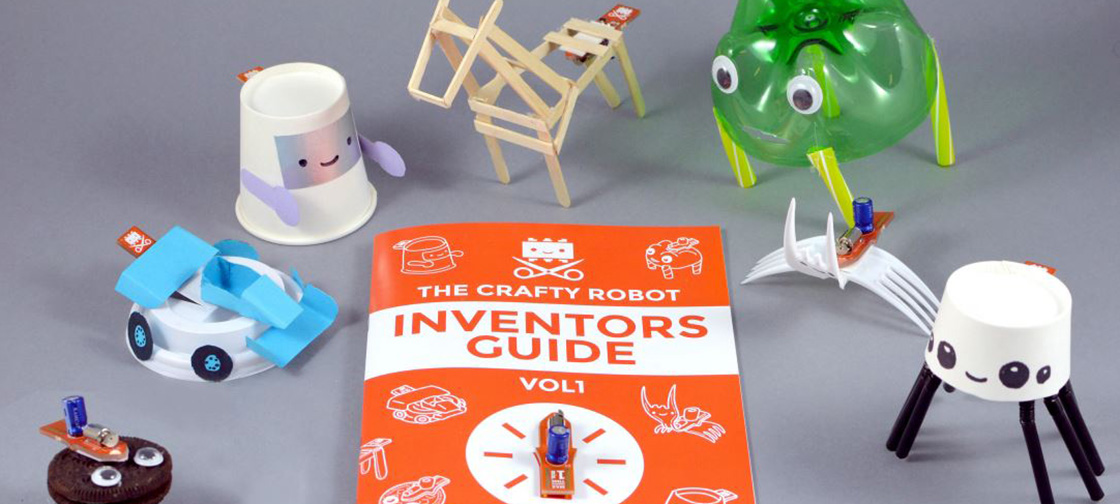If you work in the engineering or manufacturing industries, the term ‘skills gap’ probably haunts your waking hours. Despite continuing Government investment to attract young people into STEM careers, the gulf between what industry needs from the UK workforce and what it’s getting is still worryingly large.
For designer and engineer Ross Atkin, making things has been a lifelong passion, but he realises that not all children have the right opportunities to discover a design talent. That’s why he launched the Crafty Robot – a pint-sized project toy that he hopes will bring programming to life for the next generation.
I’ve always been interested in making things for as long as I can remember and I was lucky because my dad worked in manufacturing, so I knew it was a thing you could do as a career. I grew up in North London and went to a good independent school; most of the people I went to school with wouldn’t have considered anything to do with making things as a career option. I feel it’s not something that the education system is very interested in.
I studied design and technology all the way to A level, before going on to do two degrees: mechanical engineering at Nottingham and then industrial design engineering at the Royal College of Art. But in terms of the skills I use in my everyday work, I feel that the things I learned in A level design and technology have been more useful than anything I learned while doing either of my degrees. I was very lucky to have good D&T teachers, but there were only about five of us in my class.
Very important. Another factor that helped me decide to go into this field was that my dad had a colleague who was a product designer. I did an internship with him when I was 16 and found out that he’d studied Industrial Design at the Royal College of Art. I thought his job looked quite cool, so that became my plan. It was really helpful to meet him because otherwise I wouldn’t have known it was a possibility. You would think that you’d go to the RCA to learn about painting, not to learn how to design products and get things mass-produced. It feels to me that, unless you know someone who is doing this stuff as a career, it’s not going to be on your radar.
There are two things that I’m really interested in and which shape most of my decisions: I want to make a more inclusive environment for disabled people and I want to make it easier for children to get into design and engineering. I see a deficiency in the education system. So, the main emphasis with the Crafty Robot project was to try and lower the entry point for STEM activities. A lot of the programming technology around, like Raspberry Pi, is really good if a child is already interested or has a really engaged parent who likes technology. But if you don’t have that, the entry point – both financially and technically – is quite high.
I love going to events like the Maker Faire and I started to think, “What would the entry point for this world look like?” So, that’s why I made the original Crafty Robot, which was a very simple product.
Seeing how people responded to the Crafty Robot made me want to create the Smartibot. The technology that makes the Crafty Robot work is called the Fizzbit; you can use it to make a relatively light robot move around and you can build the body out of almost anything. It’s like those projects you used to see on Blue Peter as a kid, where you took stuff from around the house and just glued it together. It does move reasonably well, which is something I couldn’t achieve as a kid, not without batteries. It’s great fun and you’re learning about the process of getting it to move, but you’re not learning anything about robotics.
So, I started to think about making a robotics product and what it would be. The Smartibot is a robotics product and the AI in it is cutting edge technology, but it has the same ethos. We’ve designed it so that you can reuse the parts and make a robot out of almost anything; you can even use it to hack existing toys if you want. It runs at 6V so you can connect up the motors from any battery-operated toys to the circuit board and make it programmable and controllable. I’m getting quite excited about seeing what people do with it, because we’ve built quite a nice platform for people to be creative. It works with an app we’ve created that works as a controller and it also runs really highspeed image recognition AI that is amazingly capable.
We’ve packaged the AI in such a way that it’s quite tune-able and by doing that, we’re going to help children get a better understanding of what the technology is and how it works. I hope that this looks like a creative, fun activity that will help them learn engineering technology and it’s a good way to break down the existing barriers. I’d like the education system to become much more project-focused, as in “We’re going to make something, so we need to work out how to create it.”
People can understand much wider topics when what they’re learning feels relevant. For example, people typically don’t understand why they need trigonometry, but they use it every time they put up a garden shed to work out the length of the beams. Everyone seems to agree that programming is something children need to know, but teaching programming in an abstract context is really boring. Teaching it this way – such as, “We’ve made a robot, now we need it to avoid an obstacle” – is a much more engaging way of doing it. We’ll be shipping out the kits to our Kickstarter backers in November and we’re hoping to make the Smartibot available to the general public by Christmas.




